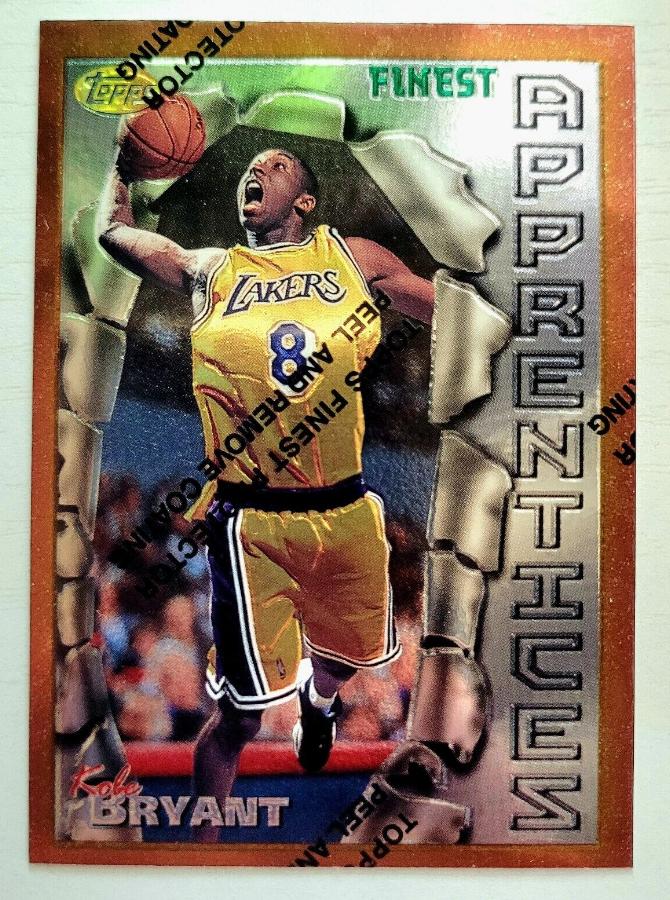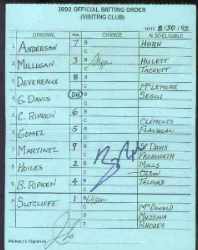Kobe Bryant - 1996-97 Finest #74 Bronze ROOKIE (Lakers)
Back of card describes his high school career !
| Grade |
NM/MINT to MINT |
| Book Value |
n/a |
| Our Price |
$ 79.95
Add to cart
|


Below are short bits & pieces on sportscard & baseball trading card collecting.
Please wander around the website for more info, prices, values & images
on vintage baseball, football, basketball, hockey, sport and non-sports cards.
1969 CITGO Coins
 In 1969, to commemorate Baseball's 100th Anniversary, CITGO released their
"Famous Baseball Player Coin Collection" of 20 brass coated metal coins.
On the front, the coins featured the player's name and a raised image of
his head. The back displayed a banner honoring baseball's s 100th Anniversary.
The coins are approx. 1" in diameter and are very susceptible to
tarnishing due to oxidation.
In 1969, to commemorate Baseball's 100th Anniversary, CITGO released their
"Famous Baseball Player Coin Collection" of 20 brass coated metal coins.
On the front, the coins featured the player's name and a raised image of
his head. The back displayed a banner honoring baseball's s 100th Anniversary.
The coins are approx. 1" in diameter and are very susceptible to
tarnishing due to oxidation.
Customers received a single coin in it's sealed pack free with a fill-up and
could pay 25 cents for additional coins.
The 20 coin set could be inserted into a cardboard backing for display.
On the back of the display was a short bio with stats of each player.
Click to view an image of the
cardboard backing and some more sample coins:
 Pictured is an unopened pack containing one coin.
Pictured is an unopened pack containing one coin.
Click for complete
1969 CITGO Coins Checklist and Prices
Note: You may be on that page right now.
|

1966 Topps Baseball Cards
Checklist & Values
Like most Topps sets of the '60s, their 1960 set had it's share of
Hall-of-Famer rookie cards with Fergie Jenkins, Jim Palmer &
Don Sutton.
The very scarce high numbers, many being even scarce short prints,
make completing this set a challenge for collectors.
Click for complete
1966 Topps Baseball card checklist, values and prices.
Note: You may be on that page right now.
|

Authentic Major League SIGNED
Game-Used LINEUP Cards (PSA)

These are the official lineup cards SIGNED BY THE MANAGER & given
to the home plate umpire before the game with the team's line-up
& batting order !!! Making them even neater, often managers made
lineup changes on these cards throughout the game.
These official lineup cards were SIGNED BY THE MANAGER and presented
to the home plate umpire before the game. They detailed the team's lineup and
batting order. Managers often made lineup changes on these cards throughout
the game, making them even more unique.
Collectors say "They are official documents of a particular game, so they are
absolutely historically relevant. The manager, he was the general in the war.
Imagine owning Eisenhower's list of who he wanted to go into battle, and then he
signed it !!! Imagine what that would be worth?"
The first dugout lineup cards were seen around 1960. Along with lineup
cards, most ended up in the trash after games, making them quite rare today.
MLB saw the light and started marketing them directly in the 2000's.
Astronomical prices have been paid for cards from special games.
$165,010 for the Red Sox dugout lineup card from Game 4 of the 2004 World Series.
$138,000 in 2007 for 1st ever All-Star Game batting order cards.
$ 40,000 for batting order cards and the pen used to fill them out from
Cal Ripken's 2,130th & 2,131st games.
Click for complete
Major League SIGNED Game-Used LINEUP cards
Note: You may be on that page right now.
|

How long have sports cards been around ? (part 1)
The first baseball trading cards date back to 1869. For many years,
baseball cards were packaged in packs of tobacco as a way to increase sales
the same way that today prizes are packaged in boxes of cereal.
In the 1920's and 1930's, candy and gum companies started packaging baseball
cards in their products as well.
Baseball card production was virtually halted in the early 1940's due to paper
shortages created by World War II. The "Modern Era" of baseball cards began in
1948 when Bowman Gum Inc. offered one card and one piece of gum in a pack for a penny.
The first important football set was the Mayo set featuring college players
in 1984. Other than the 1935 National Chicle set no other key football set was
issued until 1948 when noth Bowman and Leaf produced sets.





 In 1969, to commemorate Baseball's 100th Anniversary, CITGO released their
"Famous Baseball Player Coin Collection" of 20 brass coated metal coins.
On the front, the coins featured the player's name and a raised image of
his head. The back displayed a banner honoring baseball's s 100th Anniversary.
The coins are approx. 1" in diameter and are very susceptible to
tarnishing due to oxidation.
In 1969, to commemorate Baseball's 100th Anniversary, CITGO released their
"Famous Baseball Player Coin Collection" of 20 brass coated metal coins.
On the front, the coins featured the player's name and a raised image of
his head. The back displayed a banner honoring baseball's s 100th Anniversary.
The coins are approx. 1" in diameter and are very susceptible to
tarnishing due to oxidation.  Pictured is an unopened pack containing one coin.
Pictured is an unopened pack containing one coin.
 These are the official lineup cards SIGNED BY THE MANAGER & given
to the home plate umpire before the game with the team's line-up
& batting order !!! Making them even neater, often managers made
lineup changes on these cards throughout the game.
These official lineup cards were SIGNED BY THE MANAGER and presented
to the home plate umpire before the game. They detailed the team's lineup and
batting order. Managers often made lineup changes on these cards throughout
the game, making them even more unique.
These are the official lineup cards SIGNED BY THE MANAGER & given
to the home plate umpire before the game with the team's line-up
& batting order !!! Making them even neater, often managers made
lineup changes on these cards throughout the game.
These official lineup cards were SIGNED BY THE MANAGER and presented
to the home plate umpire before the game. They detailed the team's lineup and
batting order. Managers often made lineup changes on these cards throughout
the game, making them even more unique.
